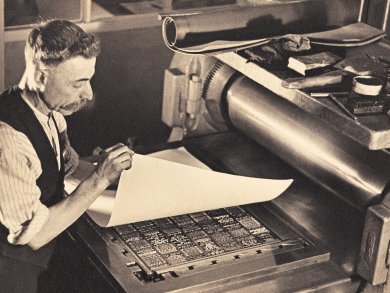A Revolution in Printing
When Gutenberg developed the principles of modern book printing, books became available to the masses. Hoping to bring technology capable of mass production to the nanometer scale, Udo Bach and this team of scientists at Monash University, Australia, and the Lawrence Berkeley National Laboratory, USA, have developed a nanoprinting process modeled on Gutenberg’s printing method. Their goal is the simple, inexpensive production of nanotechnological components for solar cells, biosensors, and other electronic systems. Their “ink” consists of gold nanoparticles, and the specific bonding between DNA molecules ensures its transfer to the substrate.
Nanopatterns with extremely high resolution are not difficult to produce with today’s technology. However, the methods used so far are analogous those used to produce the hand-written books of the era before Gutenberg; they are too slow and work-intensive for commercial fabrication. “New nanoprinting techniques offer an interesting solution,” says Bach. Along with co-workers, he has developed a process that works with a reusable “printing plate”.
Silicon Wafer Printing Plates
The printing plate is a silicon wafer—like those used for the production of computer chips—that has been coated with a photoresist and covered with a mask. The wafer is then exposed to an electron beam (electron beam lithography). In the areas exposed to the beam, the photoresist is removed, exposing the wafer for etching. The wafer is then coated with gold. When the photoresist layer is removed, the gold only sticks to the etched areas. Polyethylene glycol chains are then bound specifically to the gold through sulfur–hydrogen groups. The chains have positively charged amino groups at their ends. The completed printing plate is then dipped into the “ink”, a solution of gold nanoparticles coated with negatively charged DNA molecules. Electrostatic attraction causes the DNA to stick to the amino groups, binding the gold nanoparticles to the gold-patterned areas of the printing plate.
The “paper” is a silicon wafer coated with a whisper-thin gold film and a layer of DNA. These DNA strands are complementary to those on the gold nanoparticles, with which they pair up to form double strands. This type of bond is stronger than the electrostatic attraction between the DNA and the amino groups. When the “paper” is pressed onto the “printing plate” and then removed, the gold nanoparticles from the ink remain stuck to the “paper” in the desired pattern. The “printing plate” can be cleaned and reused multiple times. Says Bach: “Our results demonstrate that it is possible to produce affordable printed elements based on nanoparticles.”
- Gutenberg-Style Printing of Self-Assembled Nanoparticle Arrays: Electrostatic Nanoparticle Immobilization and DNA-Mediated Transfer
Y. Zheng, C. H. Lalander, T. Thai, S. Dhuey, S. Cabrini, U. Bach,
Angew. Chem. Int. Ed. 2011.
DOI: 10.1002/anie.201006991



![Synthesis of [c2]Daisy Chains via Mechanochemistry](https://www.chemistryviews.org/wp-content/uploads/2025/04/202504_RotaxanesWithSolidStateMechanochemistry-125x94.png)
